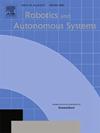Leveraging motion perceptibility and deep reinforcement learning for visual control of nonholonomic mobile robots
IF 4.3
2区 计算机科学
Q1 AUTOMATION & CONTROL SYSTEMS
引用次数: 0
Abstract
This paper introduces a novel deep reinforcement learning framework to tackle the problem of visual servoing of nonholonomic mobile robots. The visual control of nonholonomic mobile robots becomes particularly challenging within the classical paradigm of visual servoing, mainly due to motion and visibility constraints, which makes it impossible to reach a given desired pose for certain configurations without losing essential visual information from the camera field of view. Previous work has demonstrated the effectiveness of deep reinforcement learning in addressing various vision-based robotics tasks. In light of this, we propose a framework that integrates deep recurrent policies, intrinsic motivation, and a novel auxiliary task that leverages the interaction matrix, the core of classical visual servoing approaches, to address the problem of vision-based control of nonholonomic robotic systems. Firstly, we analyze the influence of the nonholonomic constraints on control policy learning. Subsequently, we validate and evaluate our approach in both simulated and real-world environments. Our approach exhibits an emergent control behavior that enables the robot to accurately attain the desired pose while maintaining the desired visual content within the camera’s field of view. The proposed method outperforms the state-of-the-art approaches, demonstrating its effectiveness, robustness, and accuracy.
求助全文
约1分钟内获得全文
求助全文
来源期刊

Robotics and Autonomous Systems
工程技术-机器人学
CiteScore
9.00
自引率
7.00%
发文量
164
审稿时长
4.5 months
期刊介绍:
Robotics and Autonomous Systems will carry articles describing fundamental developments in the field of robotics, with special emphasis on autonomous systems. An important goal of this journal is to extend the state of the art in both symbolic and sensory based robot control and learning in the context of autonomous systems.
Robotics and Autonomous Systems will carry articles on the theoretical, computational and experimental aspects of autonomous systems, or modules of such systems.
 求助内容:
求助内容: 应助结果提醒方式:
应助结果提醒方式:


